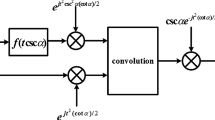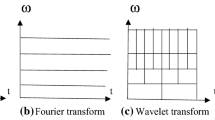Abstract
Fractional S-transform (FrST) is a time–frequency representation of signals with frequency-dependent resolution. FrST is also an advantageous technique for non-stationary signal processing applications. Till now, only linearity, scaling, time reversal, time marginal condition, and inverse FrST properties are documented. In this paper, some remaining properties of FrST are proposed to establish it as a complete transform technique. The proposed properties are convolution theorem, correlation theorem, and Parseval’s theorem. To expand the applicability of FrST as a mathematical transform tool, the multiresolution analysis concept is also documented. The multiresolution analysis has shown significant performance to develop the orthogonal kernel for FrST. Finally, the applications of proposed convolution theorem are demonstrated on multiplicative filtering for electrocardiogram signal and linear frequency-modulated signal under AWGN channel.









Similar content being viewed by others
References
O. Akay, G.F.B. Bartels, Fractional convolution and correlation via operator methods and an application to detection of linear FM signals. IEEE Trans. Signal Process. 49(5), 979–993 (2001)
R.A. Brown, R. Fayne, in A fast discrete S-transform for biomedical signal processing. International IEEE EMBS Conference (IEEE, 2008), pp. 2586-2589
D.R. Chen, D.H. Xiang, A construction of multiresolution analysis on interval. Acta Mathematica Sinica 23(4), 705–710 (2007)
D.Z. Cong, X.D. Ping, Z.J. Ming, Application to reservoir prediction and fluid identification. Appl. Geophys. 13(2), 343–352 (2016)
X. Dai, Y. Diao, Q. Gu, D. Han, Wavelets with frame multiresolution analysis. J. Fourier Anal. Appl. 9, 39–48 (2003)
E. Furman, On the convolution of the negative binomial random variables. Stat. Probab. Lett. 77, 169–172 (2007). https://doi.org/10.1016/j.spl.2006.06.007
B.G. Goodyear, H. Zhu, R.A. Brown, J.R. Mitchell, Removal of phase artefacts from fMRI data using a Stockwell transform filter improves brain activity detection. Magn. Reson. Med. 51(1), 16–21 (2004)
S. Granieri, R. Arizaga, E.E. Sicre, Optical correlation based on the fractional Fourier transform. Appl. Opt. 36(26), 6636–6645 (1997)
S.S. Kelkar, L.L. Grigsby, J. Langsner, An extension of Parseval’s theorem and its use in calculating transient energy in the frequency domain. IEEE Trans. Ind. Electr. 30(1), 42–45 (1983)
H. Khosravani, C.R. Pinnegar, J.R. Mitchell, B.L. Bardakjian, P. Federico et al., Increased high frequency oscillations precede in vitro low Mg + 2Seizures. Epilepsia 46(8), 1361–1372 (2005)
S. Liu, T. Shan, R. Tao, Y.D. Zhang, G. Zhang, F. Zhang, Y. Wang et al., Sparse discrete fractional Fourier transform and its applications. IEEE Trans. Signal Process. 62(24), 6582–6595 (2014)
W. Lu, F. Li, Seismic spectral decomposition using deconvolutive short-time Fourier transform spectrogram. Geophysics 78(2), V43–V51 (2013)
S.F. Lukomskii, Riesz multiresolution analysis on vilenkin groups. Doklady Math. 90, 412–415 (2014)
D.M. Mech, A. Cariow, A low-complexity approach to computation of the discrete fractional Fourier transform. Circuits Syst. Signal Process. 36, 4118–4144 (2017)
D. Mendlovic, H.M. Ozaktas, A.W. Lohmann, Fractional correlation. Appl. Opt. 34(2), 303–309 (1995)
H.M. Ozaktas, B. Barshan, Convolution, filtering, and multiplexing in fractional Fourier domains and their relation to chirp and wavelet transforms. J. Opt. Soc. Am. 11(2), 547–559 (1994)
S.C. Pei, J.J. Ding, Closed-form discrete fractional Fourier transform. IEEE Trans. Signal Process. 48(5), 1338–1353 (2000)
X.D. Ping, G. Ke, Fractional S-transform. Appl. Geophys. 9(1), 73–79 (2012)
C.R. Pinneger, J.R. Mitchell, Method and system for signal processing using sparse approximation of the S-transform. US Patent Application. #11/442, 991 (2006)
R. Rangayan, Biomedical Signal Analysis A Case-Study Approach (Wiley, Hoboken, 2009)
C.D. Sarris, L.P.B. Katehi, J.F. Harvey, Application of multiresolution analysis to the modeling of microwave and optical structures. Opt. Quant. Electron. 32, 657–679 (2000)
J. Shi, X. Liu, N. Zhang, Multiresolution analysis and orthogonal wavelets associated with fractional wavelet transform. Signal Image Video Process. 9(1), 211–220 (2015)
J. Shi, Y. Chi, N. Zhang, Multichannel sampling and reconstruction of bandlimited signals in fractional Fourier domain. IEEE Signal Process. Lett. 17, 909–912 (2012)
A. Singh, Fractional S-transform for Boehmians. J. Anal. Number Theory. 3(2), 103–108 (2015)
S.K. Singh, The fractional S-transform on space of type S. J. Math. 2013, 1–9 (2013)
S.K. Singh, The fractional S-transform on space of type W. J. Pseudo Differ. Oper. Appl. 4, 251–265 (2013)
R. Wang, Edge detection using convolutional neural network L. Cheng et al. (Eds.): ISNN 2016. LNCS 97(19), 12–20 (2016)
D. Wel, Q. Ran, Multiplicative filtering in the fractional Fourier domain. Signal Image and Video Process. 7, 575–580 (2013)
Author information
Authors and Affiliations
Corresponding author
Additional information
Publisher's Note
Springer Nature remains neutral with regard to jurisdictional claims in published maps and institutional affiliations.
Rights and permissions
About this article
Cite this article
Ranjan, R., Singh, A.K. & Jindal, N. Convolution Theorem with Its Derivatives and Multiresolution Analysis for Fractional S-Transform. Circuits Syst Signal Process 38, 5212–5235 (2019). https://doi.org/10.1007/s00034-019-01118-w
Received:
Revised:
Accepted:
Published:
Issue Date:
DOI: https://doi.org/10.1007/s00034-019-01118-w




